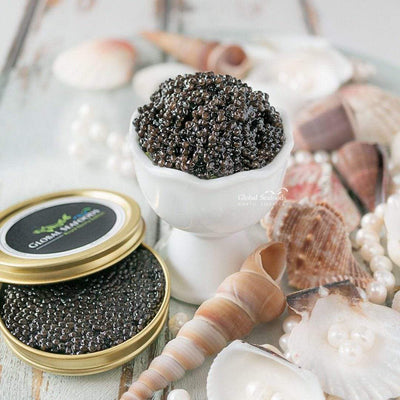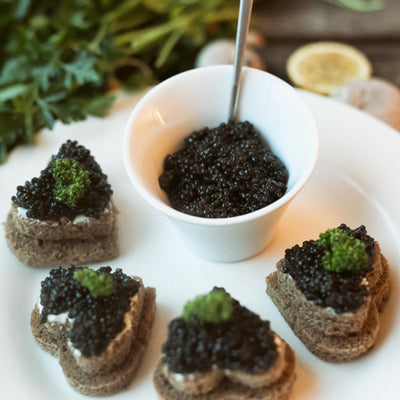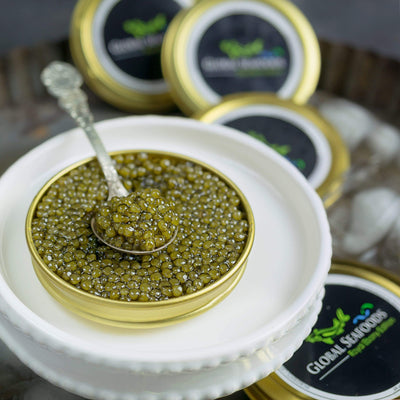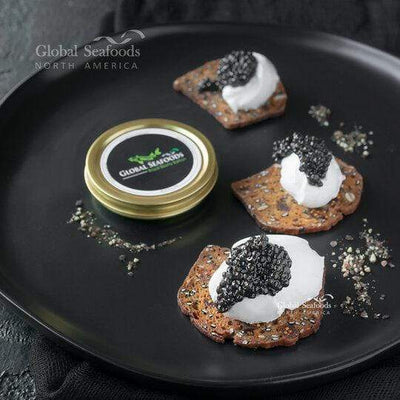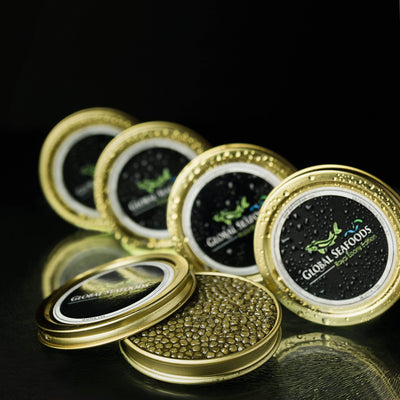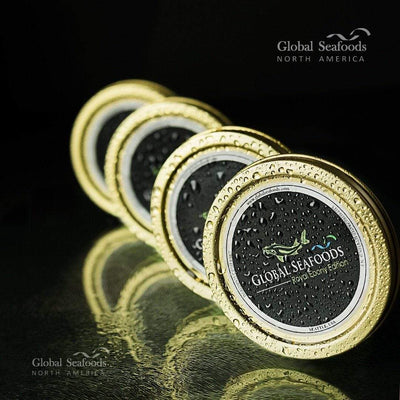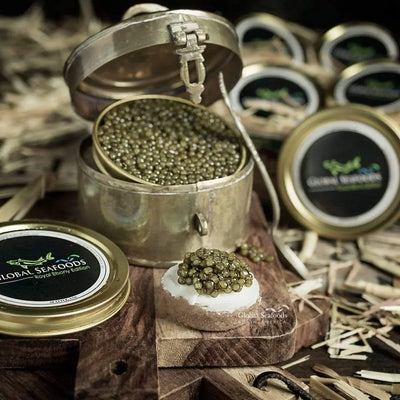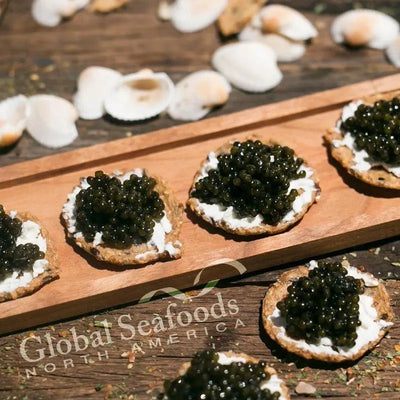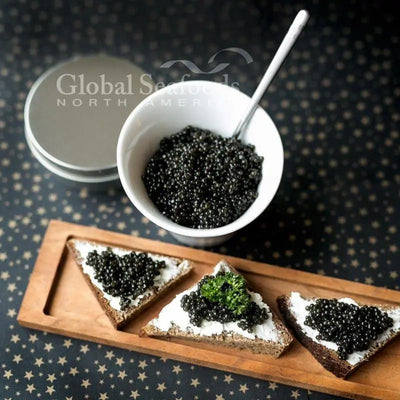Osetra Caviar Production: A Journey from Farm to Table

Osetra Caviar Production
Osetra caviar, one of the most cherished types of caviar, is known for its creamy texture, nutty flavor, and refined taste. But before this luxurious delicacy reaches your table, it undergoes a meticulous journey that involves sustainable farming practices, expert harvesting, and careful processing. Here, we’ll explore the entire production process of Osetra caviar, providing insight into what makes this delicacy so special and why sustainable farming is essential for the future of caviar.
For a closer look at the world of gourmet seafood, check out our Global Seafoods YouTube Channel.
Why Sustainable Farming is Essential for Osetra Caviar
Osetra caviar comes from the Acipenser gueldenstaedtii, or Russian sturgeon, a species once threatened due to overfishing and habitat destruction. To protect wild sturgeon populations and ensure a stable supply of caviar, sustainable farming practices have become crucial. Modern aquaculture practices allow sturgeon to be raised in controlled environments, ensuring that the caviar industry can meet demand while preserving wild populations.
"Sustainable caviar farming is essential not only for species preservation but also for maintaining the high quality that gourmet consumers expect," says Dr. Carl Safina, a renowned marine conservationist.
For responsibly sourced caviar options, explore our range of Black Caviar and Osetra Sturgeon Caviar at Global Seafoods.
The Lifecycle of Osetra Sturgeon in Farming
Sturgeon farming is a long-term commitment, with Osetra sturgeon requiring up to 10 years to reach maturity before they can produce high-quality caviar. Here’s a breakdown of the stages in the farming process:
1. Breeding and Selection
- Sturgeon are carefully selected for breeding based on genetic quality, health, and optimal growth characteristics.
- Selective breeding ensures that the fish produce caviar with the desired flavor and texture profile, which is essential for the premium Osetra caviar.
2. Raising Sturgeon in Controlled Environments
- Sturgeon are raised in large tanks or natural ponds, where water quality, temperature, and nutrition are monitored to simulate natural conditions.
- Fish health is carefully managed to avoid the need for antibiotics, which can compromise caviar quality.
3. Reaching Maturity
- Osetra sturgeon typically take 7-10 years to reach maturity, a period during which they are monitored closely to ensure optimal health.
- Farmers assess the maturity of the fish by checking for caviar development, which is crucial to ensure the best-quality pearls.
For sustainably farmed caviar, visit our selection of California White Sturgeon Caviar and Siberian Sturgeon Caviar.
The Harvesting Process: Ensuring Quality and Flavor
The harvesting stage is where the expertise of the farmers truly shines. The process requires careful handling to maintain the delicate structure and flavor of the caviar pearls.
1. Determining Readiness
- Experts use ultrasound technology to determine the readiness of the fish for caviar harvesting. This ensures that the eggs have reached their ideal size and texture.
- Harvesting at the right moment is crucial for the flavor, texture, and quality of the caviar, as caviar that’s harvested too early or late will lack the desired characteristics.
2. Gentle Extraction
- The caviar is carefully extracted to ensure the integrity of the pearls. During extraction, the eggs are separated gently from the membrane to prevent breakage, as damaged pearls lose their signature “pop.”
- Farmers strive to minimize stress for the fish during the process, which contributes to the overall quality of the caviar.
3. Rinsing and Salting
- The caviar is rinsed in cold water to remove impurities. It’s then salted, a crucial step known as “malossol,” which preserves the eggs while enhancing their natural flavor.
- The malossol technique involves using minimal salt, which is essential for preserving the delicate flavor of premium Osetra caviar.
For other high-quality caviars with similar flavor profiles, explore Beluga Caviar and Kaluga Caviar.
Processing and Packaging: Maintaining Freshness
Once the caviar is salted, it moves to the packaging stage. Proper packaging is essential to maintain the freshness and quality of the caviar until it reaches your table.
1. Quality Control and Grading
- Caviar is graded based on size, color, and texture. Only the best-quality caviar is labeled as “premium” or “first-grade” Osetra.
- Quality control is rigorous, with each batch undergoing testing to ensure it meets the high standards of gourmet caviar consumers.
2. Packaging in Airtight Tins
- Osetra caviar is packaged in airtight tins to prevent oxidation, which can compromise flavor and texture. Vacuum-sealing technology helps preserve the freshness of the caviar during transport.
- Packaging in small tins also allows consumers to enjoy fresh portions without exposing the rest of the batch to air, ensuring each serving is as fresh as possible.
3. Chilling and Storage
- After packaging, caviar is stored at optimal temperatures to maintain its quality. The caviar is kept refrigerated during storage and shipping to ensure that it arrives fresh.
- Maintaining a cold chain from the farm to the table is crucial, as caviar is highly perishable and should always be kept chilled.
For a variety of premium caviar, including Paddlefish Caviar and Sevruga Sturgeon Caviar, check out Global Seafoods.
From Farm to Table: Enjoying Osetra Caviar
When Osetra caviar finally arrives at your table, you’re experiencing the culmination of years of dedication, sustainable practices, and precise craftsmanship. Here’s how to best enjoy this delicacy:
1. Serving Tips
- Keep Chilled: Serve caviar on a bed of crushed ice to keep it at an ideal temperature.
- Use Non-Metallic Utensils: Metal can alter the flavor of caviar, so always use a mother-of-pearl or bone spoon.
2. Pairing Suggestions
- Champagne or Vodka: These classic pairings balance caviar’s richness with their crisp and clean flavors.
- Simple Bases: Serve Osetra caviar on blinis, toast points, or with crème fraîche to let its delicate flavors shine.
For more pairing ideas and serving tips, explore our Caviar Collection.
Frequently Asked Questions About Osetra Caviar Production
Q1: How is the quality of farmed Osetra caviar compared to wild-caught caviar?
Thanks to sustainable practices, farmed Osetra caviar can rival or even surpass wild-caught varieties in quality, as farms can control variables that impact flavor and texture.
Q2: How is sustainable caviar farming beneficial?
Sustainable farming helps preserve wild sturgeon populations, allowing future generations to enjoy caviar without depleting natural resources.
Q3: What makes Osetra caviar unique compared to other types?
Osetra is known for its medium-to-large pearls, golden color, and nutty flavor, which set it apart from other types like Beluga and Sevruga.
Q4: Can farmed Osetra caviar be as high in quality as traditional varieties?
Yes, advancements in farming techniques ensure that farmed Osetra caviar maintains the same premium quality, flavor, and texture as traditionally sourced caviar.
Q5: Where can I purchase high-quality, sustainably farmed caviar?
For premium options, visit Global Seafoods, where we offer a variety of responsibly sourced caviars, including Siberian Sturgeon Caviar.
For more insights and gourmet recipes, visit the Global Seafoods YouTube Channel.
Also in News

How to Make Sea Bream Sushi With Dry-Aged Tuna & Crab Roll — Step-by-Step With Chef Joshua
A complete guide to making Sea Bream sushi at home, including filleting, curing, slicing, and building a Dry-Aged Tuna & Crab sushi roll. Chef Joshua shares professional tips for restaurant-quality results.

Boiled Crab for Game Night: Everything You Need for a Perfect Seafood Party
Take your game night to the next level with a Boiled crab party. Learn the best recipes, cooking tips, and hosting hacks for a memorable seafood feast.

Boiled Crab for Date Night: A Romantic Guide to the Perfect Seafood Feast
Make your next date night unforgettable with a romantic Boiled crab experience. This guide covers everything you need to know, from ambiance to the best crab varieties.

